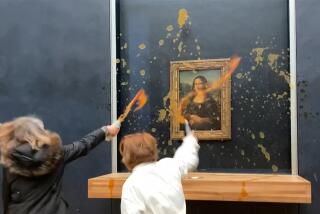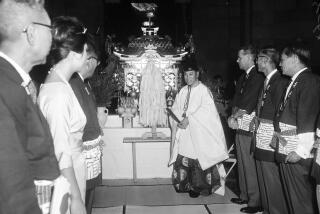Banner of Roasting Dog at City Hall Art Exhibit Is Removed
- Share via
The age-old debate about the definition of art has been revived in an unlikely forum, Los Angeles City Hall, with the bureaucrat who heads the city’s arts programs reaching the following conclusions:
A banner depicting a dog being roasted on a spit is not art. Lecterns adorned with female genitalia are.
Having made those determinations Monday morning, Adolfo Nodal removed the dog banner from the rotunda of City Hall, then pledged that the erotic lecterns and other sexually oriented pieces will remain as part of an exhibit of Filipino-American artists.
Designed to publicize an upcoming festival of Philippine culture, the art exhibit instead became the topic of a debate about cultural sensitivity, animal abuse and freedom of expression.
Nodal was labeled a “censor” by the chairman of the Festival of Philippine Arts & Culture committee. Passersby in the vaulted, marble City Hall rotunda alternately snickered at, sneered over or praised the exhibit. And one ad hoc critic delivered a review through actions--repositioning the erotic lecterns so that they were partially hidden behind marble pillars.
The exhibit had opened innocently enough Friday evening, when about two dozen paintings and sculptures were placed beneath the banner, which was created by a group led by acclaimed Filipino-American artist Manuel Ocampo. No one seemed particularly offended at that time, according to several people who attended the reception.
But when City Hall opened for business Monday morning, some employees and others were not pleased with the exhibit on display just inside the Spring Street entrance. After receiving half a dozen complaints from city workers, Nodal rushed from his office four blocks away and removed the offending banner.
The 12-foot-wide work depicted a dog roasting over flames on a spit labeled “This is America,”--complete with a swastika-emblazoned handle. The banner also announced the upcoming festival, which is subtitled “Ugat Pilipino,” or “Filipino Roots.” It included images of a monkey and the festival’s sponsorship by the Lost Angeles City Cultural Affairs Department.
The artists who created the banner could not be reached to explain the symbolism, but a member of the festival committee said it represented American oppression of the Philippines and Filipinos. The monkey represented a racial slur sometimes used to describe Filipinos, two committee members said.
“Basically that oppression has happened from the time Admiral (George) Dewey arrived up until now,” said Oyie Esquera, one of the committee members, “and now it’s just in economic terms.
“Basically I agree with what (the artists) were saying,” Esquera added. “If somebody got offended by that, I am sorry.”
A handful of other Filipino-Americans who saw the banner before it was removed read it more literally and said it only served to validate stereotypes.
“We really don’t roast dogs,” said Amelia Angeles of Monterey Park. “We don’t do that.”
City Engineer Ricardo Valencia was near tears and said his knees were shaking because he was so offended. “It’s too degrading,” Valencia said. “I cannot believe what I am seeing. I don’t feel good about this. I feel weak.”
A woman, who did not give her name, said she took offense for a different reason: “I think it’s horrible what they are doing to that dog.”
City Council President John Ferraro said: “Americans don’t look kindly on pets being barbecued.”
Nodal agreed that the banner could be offensive to some Filipino-Americans and animal lovers. Removal of the banner was not censorship, he said, because it was intended merely to be a sign and not an artistic work. Nodal said he would never remove any of the official works in the exhibition.
But Joel Jacinto, chairman of the committee that has received $15,000 from the city to put on the festival, called the action an infringement on artistic freedom.
“I think it was considered part of the art exhibit,” Jacinto said. “It was an artist’s statement and it was produced by artists.”
Nodal met Monday afternoon with several artists involved in the exhibit in an attempt to quell the furor with a compromise.
Jacinto said he hoped an agreement can be reached to reinstall the banner after removing the reference to the Cultural Affairs Department.
The exhibit contained other provocative images, but some were so abstract that few passersby seemed to notice. Several sexually oriented works did catch a few eyes though.
One woman, who did not give her name, looked disdainful as she examined the unusual lecterns, a large painting of a female form dominated by a vagina and another painting of a couple locked in an erotic embrace. “Smut!” she muttered.
But another viewer, a city employee, said that under the tenets of Tantric Buddhism, which he practices, such erotic images are considered spiritual.
“That is God and people should not be offended by it,” he said. “They are beautiful images. They are expressive.”
More to Read
The biggest entertainment stories
Get our big stories about Hollywood, film, television, music, arts, culture and more right in your inbox as soon as they publish.
You may occasionally receive promotional content from the Los Angeles Times.











